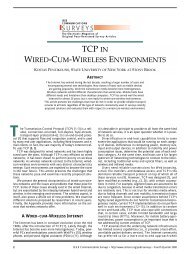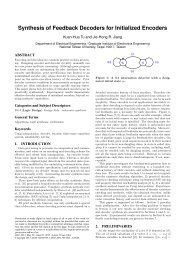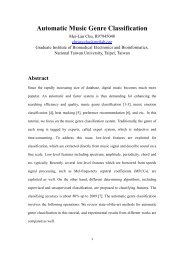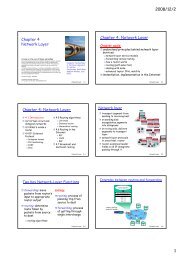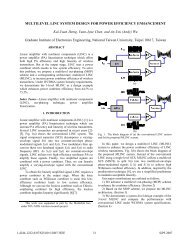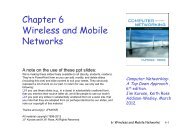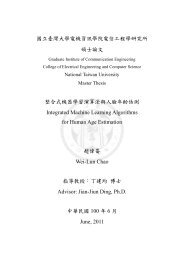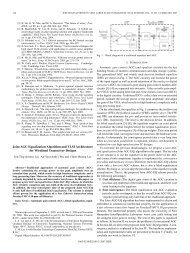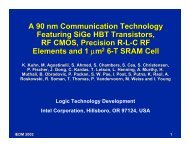A New Noise-Tolerant Dynamic Circuit Design with Enhanced PDP ...
A New Noise-Tolerant Dynamic Circuit Design with Enhanced PDP ...
A New Noise-Tolerant Dynamic Circuit Design with Enhanced PDP ...
Create successful ePaper yourself
Turn your PDF publications into a flip-book with our unique Google optimized e-Paper software.
ecause of the existence of direct conducting path.No matter how to enhance the noise immunity bypreventing the dynamic nodes from floating or by raising thesource voltage of pull-down nMOS transistors, thenoise-tolerant mechanisms all are not under protection;therefore, the noise-tolerant mechanism may possibly bedestroyed by the noise interference. Consequently, all theseexisting techniques must still pay expensive design penalty interms of speed, power, and area to achieve the noise tolerantgoal. Especially as the requirement of noise tolerance isincreased along <strong>with</strong> the progress of process technology, thedesign overhead will further increase dramatically.IV. THE PROPOSED ISOLATED NOISE-TOLERANTDYNAMIC CIRCUIT TECHNIQUE(a)(b)Fig. 3. Proposed isolated noise-tolerant technique: (a) generalcircuit schematic, (b) buffer schematicA. Characteristics of the Proposed INT TechniqueFig. 3(a) is the proposed isolated noise-tolerant (INT)technique and it concludes a noise isolated mechanism and anoriginal pull-down network. Fig. 3 (b) is proposed buffercircuit, MNT1 (NT-transistor) provides a path to transmit noiseto raise the source voltage and enhances the noise immunity.MNT2 is utilized to precharge node V G to make MNT1conduct and turned off to protect the noise-tolerant mechanismfrom destroyed in the evaluation phase; MNT3 can provide adischarge path for maintaining function correction; MNT4 isutilized to prevent the occurrence of voltage overshooting. Theweak feedback keeper can assist in preventing the dynamicnode from floating. The main difference between the proposedINT technique and conventional noise-tolerant techniques isthat the noise-tolerant mechanism in the INT circuits can beprotected from being destroyed even if the noise input isenormous.B. Operation of the Proposed <strong>Noise</strong>-<strong>Tolerant</strong> TechniqueThe operation of the proposed circuits can be separatedinto pre-charge phase and evaluation phase. To simplify theexplanation of operation in the proposed noise-tolerant circuit,we take the dynamic buffer circuit as example. The sameoperation principle can be popularized to all other dynamiccircuits.1) Pre-charge Phase:In the pre-charge phase, the clock signal CLK is low andthe inverse clock signal CLKb is high. The dynamic node X ischarged to logic high and the output node OUT is logic low. Inthis phase, Fig.4(a) is a simple illustration of the buffer circuit,node V G in the buffer circuit is precharged to high to makeMNT1 conduct because MNT2 is turned on by CLKb andMNT3 is turned off by OUT. The conduction of MNT1 isessential for raising the source voltage of MN1 to enhance thenoise-tolerance in evaluation phase.2) Evaluation Phase:In the evaluation phase, CLK is switched to high and CLKb isswitched to low. The dynamic node X is floating because MP1is turned off by CLK; therefore, the noise-isolatednoise-tolerant mechanism must be activated in this phase toprevent the floating node X from being disturbed by the noise.As the input A is logic “0”, the noise-tolerant mechanism isactivated by MNT2 and MNT3. Fig. 4(c) is a simpleillustration, MNT2 will be turned off as CLKb switches to lowand MNT3 will also be turned off since the input A is logic “0”;therefore, node V G is isolated and latched in logic high tomaintain the conduction of MNT1. As noise interrupts thecircuit as illustrated in Fig.4 (b), the noise charge can bedrained away immediately through MNT1 to node V S and thesource voltage of MN1 will be raised by the disturbing signal.Hence, the noise-tolerant ability can be enhanced. Because thenoise-tolerant ability is enhanced by raising the source voltageof MN1; therefore, it is important to maintain the conductingsituation of MNT1 to achieve good noise immunity. In theevaluation phase of proposed circuit, the conduction situationof MNT1 can be hold because the node V G is isolated.Therefore, the noise-tolerant mechanism can be protected andthe noise-tolerant ability will not degrade even underenormous noise interference. As the input A is logic “1”, thenode X will be pull-down to logic low and OUT is logic high.As a result, the charge in the node V G can be discharged to turnoff MNT1 to ensure the correctness of function in normalmode, as illustrated in Fig. 4(d).(a)(c)(d)Fig. 4. The operation of the proposed noise-tolerant circuit:(a) operate in pre-charge phase (b) in evaluation phase <strong>with</strong>noise interference operates in evaluation phase. (c) normaloperation in evaluation phase as input signal is “0” (d)normal operation in evaluation phase as input signal is “1”C. <strong>Noise</strong>-Isolated <strong>Noise</strong>-<strong>Tolerant</strong> PropertyThe gate voltage of noise-tolerant transistor(NT-transistor) dominates the capability of noise-tolerance.The degradation of gate voltage results in the descent ofnoise-tolerant ability. In the conventional noise-toleranttechniques, the gate voltage of noise-tolerant transistor usually(b)296
degrades as the interference of noise goes serious. Asillustrated in Fig. 5(a), the gate voltage of noise-toleranttransistor degrades quickly as the injecting noise is highenough to turn the pull-down nMOS transistor on. Thedegradation of gate voltage will further aggravate theinterference of noise because the noise tolerant mechanism isdestroyed. Preventing the degradation of gate voltage canpreserve the ability of draining the noise charge away. In theproposed design, the gate voltage of noise-tolerant transistorMNT1 can be isolated from noise interference; therefore, thenoise-tolerant mechanism can be prevented from beendestroyed. As illustrated in Fig. 5(a), the gate voltage of MNTin the proposed circuit will not degrade even if the injectingnoise is enormous. The corresponding source voltage (Vs) isillustrated in Fig. 5(b). From Fig. 5(b), we can see that thesource voltage is raised in a noise-dependent manner in activestyle noise-tolerant circuits. Moreover, the source voltage canstill be raised even under serious noise interference. Therefore,in the proposed design, the noise-tolerant ability can be greatlyimprovedNIC, we can distinguish the noise-tolerant ability of differentdesign styles. The upper curves in Fig. 6 represent the circuitcan operate in noisier environment. As compared <strong>with</strong> the stateof the art design, the noise immunity can be enhanced by 1.5X.To quantify the information in the NIC, average noisethreshold energy (ANTE) [1, 5, 9, 10] is a convenient metricthat can be directly derived from the NIC by averaging theenergy of noise pulses that cause the function error and it canbe normalized to NANTE. Table 1 shows the comparisonresults of ANTE and NANTE, the proposed circuit is moreenergy efficient and expends 39-81% less energy.Fig.6. <strong>Noise</strong> immunity curves (NICs)(a)Table 1 ANTE comparisonANTE NANTE Energy Savingproposed(V 2 -ns) 1.170 1domino(V 2 -ns) 0.200 5.84 81%twin(V 2 -ns) 0.704 1.66 39%mirror(V 2 -ns) 0.687 1.70 41%nmos_pull_up 0.460 2.53 60%pmos_pull_up 0.321 3.63 72%(b)Fig. 5. The analysis of (a) gate voltage and (b) sourcevoltage of the noise tolerant transistor <strong>with</strong> the injectingnoise.Fig. 7. The trade-off of the noise threshold against delayV. PERFORMANCE ANALYSIS OF NOISE-TOLERANTDYNAMIC CIRCUIT TECHNIQUEIn this session, we will discuss the trade-off between thenoise-tolerant enhancement and performance overhead. Theperformance comparison results of various noise-toleranttechniques in dynamic circuits are based on TSMC 0.18umprocess technology. In the 2-input AND gate, the input patternis applied based on the consideration of the worst case of noiseinterference, while input A is logic “1” and input B initially islogic “0”.In the following, we will further take the noise durationinto consideration, we can use the noise immunity curves(NICs) [1, 5, 9, 10] to compare the performance of variousnoise-tolerant techniques. This curve is the locus of amplitude(V noise ) and noise duration (T noise ) combinations. By using theFig. 8. The trade-off of the noise threshold against <strong>PDP</strong>As the size of NT-transistor using to raise the sourcevoltage increases, the NICs can be raised up to perform betternoise immunity. However, the design overhead will also297
increase; especially the delay time of dynamic circuits will bepostponed. We compare the delay time while applyingdifferent noise-tolerant techniques in Fig. 7. As shown in Fig. 7,the mirror technique which is a kind of the passive modenoise-tolerant technique must spend expensive designoverhead up to 39X NT-transistor size to operate accuratelyunder severely noisy signal. However, as shown in Fig. 7, theproposed design can easily provide low design overheadagainst noise, while the twin-transistor technique must pay23X extra size effort and 0.7X speed penalty. In other words,under the same performance sacrifice of speed, the proposeddesign has better noise tolerant ability. In Fig. 8, we comparethe performance penalty in terms of power-delay-product (<strong>PDP</strong>)for enhancing the noise tolerance. The proposed designprovides evident superiority in saving the performance penaltyas compared <strong>with</strong> the twin and mirror techniques. In the verynoisy environment which the SNR is low to 3.2dB, theproposed design can save 46% and 81% performance penaltyin <strong>PDP</strong>.Table 2 Performance SummaryImplementation Process TSMC 0.18umSupply Voltage 1.8VClock Frequency100MHz<strong>Design</strong> Type Domino Mirror[8] Twin[9] ProposeTransistor Count 1128 1170 1206<strong>Circuit</strong> Area( mm^2) 0.102 0.157 0.183ANTE (V 2 -ns) 0.269 0.565 1.077Delay Time @SNR=3.2dB 517ps 280ps 191psDelay Time @SNR=5dB 230 220 180<strong>PDP</strong> @SNR=3.2dB(mw*ps) 97.6 33.5 18.9<strong>PDP</strong> @SNR=5dB(mw*ps) 25 27.3 18NT-Size @SNR=3.2dB 39x 23x 3xNT-Size @SNR=5dB 6x 8x 2.5xⅥ. CHIP IMPLEMENTATIONWe implement the proposed noise-tolerant technique inthe Manchester adder to demonstrate the performance ofnoise-tolerance and verify the function in the presence of noise.Fig.9 is the carry generation circuit <strong>with</strong> the proposed INTmechanism which shows in the dash line block and thedash-line transistors are used to solve the direct conductingpath problem. Fig.10 is the chip layout of the total area <strong>with</strong>outpad is 0.68*0.15 mm^2. Chip performance is summarized inTable 2. Comparing <strong>with</strong> different noise-tolerant technique, theproposed design has a lower delay time and <strong>PDP</strong>. Moreover, inthe seriously noisy environment, the proposed design uses only3X NT-size to operate accurately. The carry-out waveform ofthe Manchester adder using the proposed and the conventionaldesign is shown in Fig. 11. We input the AWGN noiseinterference to the adder and the waveform reveals that thenoise tolerant technique can effectively immunize the adderfrom the noise interference.Fig. 11. Simulation Waveform in Manchester adder (a)employs the proposed noise-tolerant technique. (b) uses theconventional dynamic adderV. CONCLUSIONSIn this paper, a high noise-immunity and energyefficiency design technique for dynamic circuits is presented.Comparing <strong>with</strong> the state of the art design, the noise immunitycan be enhanced up to 1.5X. In the low SNR (3.2dB)environment, the proposed design can save 81% performancepenalty in <strong>PDP</strong>.REFERENCESFig. 9. The proposed noise-tolerant technique implemented inManchester adderFig. 10. Chip layout[1] N. R. Shanbhag, “Reliable and efficient system-on-chip design,”IEEE Computer Magazine, vol 37, pp. 42 –50, Mar. 2004.[2] P. Larsson and C. Svensson, "<strong>Noise</strong> in Digital <strong>Dynamic</strong> CMOS<strong>Circuit</strong>s", IEEE Journal of Solid-State <strong>Circuit</strong>s, vol.29, pp.655-662,Jun.1994.[3] K. L. Shepard and V. Narayanan, “<strong>Noise</strong> in deep submicron digitaldesign,” in Proc. Int. Conf. Computer Aided <strong>Design</strong>, 1996,pp.524–531.[4] M. H. Chowdhury and Y. I. Ismail, “Analysis of Coupling <strong>Noise</strong>and Its Scalability in <strong>Dynamic</strong> <strong>Circuit</strong>s,”in Proceeding of IEEE Custom Integrated <strong>Circuit</strong>s Conference, pp.505- 508, Oct. 2004.[5] L. Ding and P. Mazumder, “On circuit techniques to improve noiseimmunity of CMOS dynamic logic,” IEEE Transactions on Very LargeScale Integration (VLSI) Systems, vol 12, pp. 910 – 925, Sept. 2004.[6] A. Alvandpour, R. K. Krishnamurthy, K. Soumyanath, and S.Y.Borkar, “A conditional keeper technique for sub-0.13u wide dynamicgates,” in Proceeding of International Symposium on VLSI <strong>Circuit</strong>s,2001, pp. 29–30.[7] G. P. D’Souza, “<strong>Dynamic</strong> logic circuit <strong>with</strong> reduced chargeleakage,” U.S. Patent 5 483 181, Jan. 1996.[8] E. B. Schorn, “NMOS charge-sharing prevention device fordynamic logic circuits,” U.S. Patent 5 838 169, Nov. 1998.[9] L. Wang and N. R. hanbhag, “<strong>Noise</strong>-tolerant dynamic circuitdesign,” in Proceeding of International Symposium on <strong>Circuit</strong>s andSystems, 1999, pp. I 549–552.[10] G. Balamurugan and N.R. Shanbhag, “The twin-transistornoise-tolerant dynamic circuit technique,” IEEE J. Solid-State <strong>Circuit</strong>s,vol. 36, no. 2, pp. 273-280, Feb. 2001.298



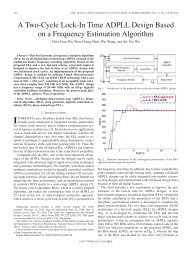

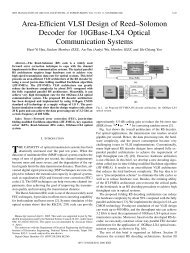
![On [n, n - 1] convolutional codes with low trellis complexity ...](https://img.yumpu.com/45854741/1/190x245/on-n-n-1-convolutional-codes-with-low-trellis-complexity-.jpg?quality=85)
